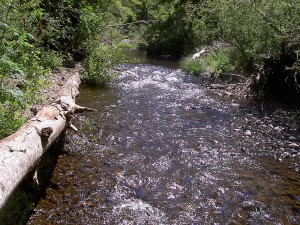The fieldtrip to watch salmon spawn this last weekend was incredible. A group of about 15 of us, went on a tour of the Lagunitas watershed, organized and led by SPAWN (the Salmon Protection and Watershed Network), a non-profit working to protect the endangered salmon of the area. It was a great group of people and I learned a ton. The only small detail was that I didn’t see salmon.
First of all, why I am talking about salmon? This project is about water, not about wildlife right? Besides being extraordinarily beautiful animals with a lifecycle so dramatic and tragic it could be out of a Shakespearean play, these animals are a reflection of the state of the ecology of our ocean and rivers, our water. Since the 1800s, the story of their species has paralleled our quest to shape California’s waterscape to our liking. And while we have not recognized it until recently, their problems are our problems. Because salmon live their lives in the ocean and in rivers, they tell us something about both.
“(Salmons’) problems are an ecological mirror of ocean imbalances and river imbalances,” Megan, a naturalist from SPAWN said.
And their problems are many. The Lagunitas watershed now hosts the biggest population of Coho salmon in Central California- they are endangered. We are towards the end of their spawning season and so far this year, only 46 redds, the nests where salmon lay their eggs have been found. In an average modern year, 200 to 300 redds will be found, 500 in a good year. What’s going on?
Keep in mind that a Coho salmon’s natural lifecycle is fraught with challenges and obstacles. After making it to adulthood and living three years in the eat-or-be-eaten ocean, sometimes traveling 2000 miles across the ocean, adult salmon somehow find the creek or river mouth of their birth. Urged forward by primal instinct, salmon swim upriver, hurdling themselves over logs and rocks to find the perfect place to lay their eggs. The nesting conditions must be perfect for eggs/babies to survive. After the nest is made and guarded for a few weeks, the adult salmon die. So imagine, even under normal circumstances, it is a hard life. Throw certain greedy and unthoughtful humans into the picture and well, you’ve got a problem.
Since the 1800s, Coho salmon in the Lagunitas watershed have lost 50 percent of their spawning habitat because of dams. While salmon can hurdle themselves up to six feet over obstacles in their way, a two hundred to three hundred foot dam puts an end to their journey. On our walk this weekend, we visited Peter’s Dam, the place where salmon can go no further up Lagunitas Creek. While there is 33 miles of creek before the dam, in some river systems salmon used to go up to 2000 miles on their runs- for example, being able to get from the Pacific through Oregon to Idaho. In California, only one major river has no dams on it.
It was also our habit, until recently, to remove the debris piles, of fallen trees and other refuse, as well as remove gravel to make our state and national parks’ rivers look ‘neat.’ Salmon need the protected places debris piles create to build their nests and gravel is an absolutely essential ingredient to safe and well-oxygenated eggs/babies.
With all this change, salmon have been pretty resilient. But in the last few years, a few ‘natural’ fluctuations have cut their numbers dramatically.
“Habitat destruction over the last 100 years..now limits our streams and rivers from producing enough young juveniles to compensate for the normal fluctuations in ocean/climatic conditions that the species has weathered over thousands of years,” Todd Steiner, founder of SPAWN, said in a recent newsletter.
A few years ago, severe weather disturbed nests, babies, and spawning adults in the creek and at the same time, poor ocean conditions met those who survived.
This is a call to us. We still have these beautiful and highly unique fish in our rivers, though in small numbers. We still have rivers. We have an opportunity to turn the eco-balance around, to change our way of looking at nature as a resource that is ours alone. As we see now, it is not working to play ‘God’ with nature and change anything we want to. Cultivating a new attitude of looking and learning from nature before we change it, and making small, holistic changes only when we must, as well as recognizing that the environment’s health is our health is just the beginning.
If you’re inspired to give a hand to these beautiful creatures, visit SPAWN’s website and see how to get involved- in watershed restoration, in fish rescue, or simply learning about them and spreading the word.
Thank you to the knowledgeable naturalists at SPAWN for their time and dedication!
Sources for this article: naturalists at SPAWN and the Intro to Water in California by David Carle
Picture available for redistribution under Creative Commons license.


My cousin recommended this blog and she was totally right keep up the fantastic work!
found your site on del.icio.us today and really liked it.. i bookmarked it and will be back to check it out some more later